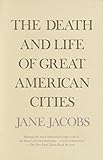If you walk down a street in, say, Amsterdam, or down one in St Louis, it's two very different experiences - Amsterdam teeming with life, it feels close, safe and small. You can bike anywhere in 30 minutes; the layout of the city itself encourages pedestrian traffic. The marginal cost of popping into the bakery next to the wine store is 30 seconds, so the streets are lined with small mom & pop stores that care, genuinely care about how their street is doing, that the sidewalk is welcoming..
St Louis is a city replanned for cars - you do not move in St Louis but by automobile. The marginal cost of going to two stores instead of one is at least ten minutes, so you always go to Schnucks and call it a day. Biking from one point to another is a lost cause - I literally saw a woman crush the skull of a bicyclist with her SUV in St Louis just last month, he's dead now because fuck bike lanes.
And Amsterdam is three times as populous as St Louis.
Cannot recommend https://www.amazon.com/Death-Life-Great-American-Cities/dp/0... enough for this - urban planning has a massive impact on our lives.
If you want to dive deeper into this, Jane Jacobs's "Death and Life of the Great American Cities" is an incredible and very approachable book on urban planning: https://www.amazon.com/Death-Life-Great-American-Cities/dp/0...
Also read up on all the work Singapore is doing to increase density without ruining their economy or environment while improving livability.
And some further reading on the dynamics of city growth: http://journals.plos.org/plosone/article?id=10.1371/journal....
I love thinking about this stuff, complex and fascinating :)
Many of the counterarguments in these comments (especially that smaller cities, or rural areas, are fine even when American suburbs are not) are actually reasonable, and Jacobs covers them in her book.
Since it's from 1961, you might think the insights would be dated, but they're not. She was complaining even as these mistakes were being made, and it's fascinating to read so many of her predictions that we can now say clearly came true.
On the economic side, I think cities prefer single family devs because they can levy more taxes (as they do it per acre, I think). I don't see why they don't tax by livable (inhabitable) space and land, that way they can compensate for the greater density in required services.
Anyway, I've begun reading Jane Jacobs's "The Death and Life of Great American Cities"[1]. It provides interesting insight into the suburbanization of America (and other places, of course, but she looks at the American side of it) and its impact on quality of life and how it may be time to rethink the suburbanization and revitalize cities to make the inner cores actual livable places, not just places where people drive in for work. It's an old tome, but it's still very relevant today.
W:re Soviet style (and even section 8 in the US and Council Estates in the UK) the planners were kind of utilitarian and naive. They more or less saw them as solutions for housing people as if they were storing objects. Little in the way of allowances for human nature. The plans were a bit too abstract. For example, let's say they thought it'd be nice to have a community area. They'd afford a room somewhere in a building, but put little thought on where might be optimum or how people might use it and have equally easy access to it. So they might end up being dingy unused areas which might just get defaced or used by low level criminals.
[1] http://www.amazon.com/Death-Life-Great-American-Cities/dp/06...

https://mitpress.mit.edu/books/learning-las-vegas
https://www.amazon.com/Death-Life-Great-American-Cities/dp/0...
and also
https://www.amazon.com/Visual-Display-Quantitative-Informati...
I think there is nothing wrong with the "design" of reddit and HN. Those designs do the job; I think in most cases the design is just a container for the content. People come to these sites because they want to enjoy the discussion, not because they want to enjoy art.
If anybody has a complaint about the design of HN, it is that they have a hard time reading it on phones with small screens.